10 Stunning Rotala Species to Elevate Your Aquascape Background
When it comes to crafting a lush, layered aquascape, few plant genera offer the charm and versatility of Rotala. Known for their delicate stems, vibrant coloration, and graceful growth patterns, Rotala species can turn a simple aquarium into a living watercolor. Whether you’re aiming for a subtle green forest or a fiery crimson curtain, these 10 Rotala varieties will give your tank the depth and dynamism it deserves. Let’s dive into the world of these aquatic wonders and find the perfect background stars for your underwater masterpiece.
- Rotala rotundifolia
- Rotala rotundifolia 'Green'
- Rotala rotundifolia 'Red'
- Rotala macrandra – Giant Red Rotala
- Rotala macrandra 'Green' – Giant Green Rotala
- Rotala wallichii
- Rotala sp. 'Nanjenshan'
- Rotala indica
- Rotala ramosior
- Rotala sp. 'H’ra'
Rotala rotundifolia
- Scientific name: Rotala rotundifolia
- Position: Midground to background
- Care level: Easy
- Growth rate: Fast
- Height: 8 – 20 inches (20 – 50 cm)
- Lighting: Low to high
- CO2: Optional
Rotala rotundifolia, commonly known as Dwarf Rotala, is a beloved aquascaping plant prized for its delicate, narrow leaves that shift from green to vibrant pinkish-red under intense lighting. Its ability to create a bushy, feathery effect when planted in dense groups makes it a standout choice for the background of planted tanks, adding dynamic movement and vivid color to layouts. This Southeast Asian native is highly adaptable, appealing to both beginners and seasoned aquarists seeking a versatile plant to enhance their aquascape’s aesthetic.
In aquariums, Rotala rotundifolia excels at bringing depth and contrast, especially when paired with green foreground plants like mosses or carpeting species. Its responsive coloration, which intensifies with strong light and nutrient availability, allows aquarists to craft visually striking displays, making it a staple in nature and Dutch-style aquascapes. The plant’s compatibility with peaceful fish and shrimp, such as tetras and Neocaridina, further enhances its popularity for community tanks.
Rotala rotundifolia ‘Green’
- Scientific name: Rotala rotundifolia ‘Green’
- Position: Midground to background
- Care level: Easy
- Growth rate: Fast
- Height: 8 – 20 inches (20 – 50 cm)
- Lighting: Low to medium
- CO2: Optional
Rotala rotundifolia ‘Green’ is a vibrant variant that maintains a consistent lime-to-olive green hue, offering a refreshing, calming presence in aquascapes. Unlike its red-toned counterparts, it retains its lush green color even under high lighting, creating a soothing contrast against red or purple stem plants. Its upright, dense growth forms a forest-like backdrop, ideal for natural layouts aiming for a serene, organic feel.
This variety’s steady growth and minimal maintenance needs make it a versatile addition to both small and large tanks. When grouped tightly, Rotala rotundifolia ‘Green’ adds texture and volume, complementing bolder plants like Ludwigia or Alternanthera. Its compatibility with peaceful tank mates, including shrimp and small fish, ensures it integrates seamlessly into community aquariums, providing both aesthetic appeal and a natural habitat.
Rotala rotundifolia ‘Red’
- Scientific name: Rotala rotundifolia ‘Red’
- Position: Midground to background
- Care level: Easy
- Growth rate: Fast
- Height: 8 – 20 inches (20 – 50 cm)
- Lighting: Medium to high
- CO2: Recommended
Rotala rotundifolia ‘Red’ is a captivating variant known for its striking red to orange hues that emerge under high light and nutrient-rich conditions. Its fine, elongated leaves grow densely on slender stems, creating a fiery, intense backdrop that adds passion to aquascapes. When planted in tight groups, it serves as a dramatic focal point, contrasting beautifully with green midground or foreground plants.
In planted tanks, Rotala rotundifolia ‘Red’ brings bold color and vertical structure, making it a favorite for aquarists aiming to create high-impact layouts. Its vivid tones pair well with species like Anubias or Cryptocoryne, enhancing the tank’s visual depth. Safe for peaceful fish and shrimp, this plant thrives in setups where its vibrant coloration can shine, elevating the overall aesthetic of the aquarium.
Rotala macrandra – Giant Red Rotala

- Scientific name: Rotala macrandra
- Position: Midground to background
- Care level: Moderate
- Growth rate: Moderate
- Height: 10 – 20 inches (25 – 50 cm)
- Lighting: High
- CO2: Recommended
Rotala macrandra, or Giant Red Rotala, is a breathtaking stem plant renowned for its large, rounded leaves that display deep crimson to wine-red shades, making it a true showstopper in aquariums. Often used as a central visual anchor, its bold coloration and elegant form create a striking contrast against green or finer-textured plants, transforming any aquascape into a vibrant masterpiece.
In high-tech tanks, Rotala macrandra’s rich red hues and voluminous growth make it ideal for creating dramatic focal points or lush backgrounds. Its compatibility with peaceful species like rasboras and shrimp ensures it fits well in community setups, though its delicate leaves may need protection from herbivorous fish. This plant’s intense beauty makes it a top choice for experienced aquarists seeking a bold, colorful statement.
Rotala macrandra ‘Green’ – Giant Green Rotala
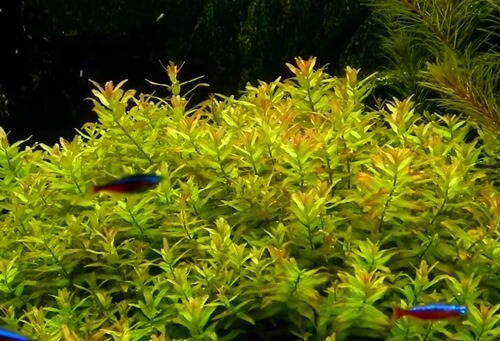
- Scientific name: Rotala macrandra ‘Green’
- Position: Midground to background
- Care level: Moderate
- Growth rate: Moderate
- Height: 10 – 20 inches (25 – 50 cm)
- Lighting: Medium to high
- CO2: Recommended
Rotala macrandra ‘Green’ offers a softer, more subdued aesthetic with broad, semi-translucent leaves in bright to apple-green tones. Its plush, voluminous growth adds softness and depth to aquascapes, particularly when placed alongside rigid or narrow-leaved species, creating a balanced and harmonious layout. This plant brings a calming, natural vibe to any tank.
In aquariums, Rotala macrandra ‘Green’ excels as a midground or background plant, enhancing texture and contrast without overpowering other elements. Its compatibility with peaceful fish and shrimp, such as guppies or Neocaridina, makes it a versatile addition to community tanks. The plant’s gentle green hues and lush appearance make it a favorite for aquarists seeking a serene, forest-like aesthetic.
Rotala wallichii
- Scientific name: Rotala wallichii
- Position: Midground to background
- Care level: Moderate
- Growth rate: Fast
- Height: 6 – 16 inches (15 – 40 cm)
- Lighting: High
- CO2: Recommended
Rotala wallichii is a delicate, fine-leaved species celebrated for its feathery texture and pinkish-red to golden tips that develop under strong lighting. Its airy, graceful growth sways gently with the tank’s current, adding an elegant, dynamic quality to the background of aquascapes. This plant is a favorite in high-tech and Dutch-style setups for its refined beauty and vibrant contrast.
In planted tanks, Rotala wallichii creates a soft, ethereal backdrop that pairs beautifully with denser or green plants like Java Fern or Hygrophila. Its compatibility with small fish and shrimp ensures it thrives in community aquariums, where its delicate structure adds a sense of movement and sophistication. The plant’s unique texture makes it a standout choice for aquarists aiming for intricate, colorful designs.
Rotala sp. ‘Nanjenshan’
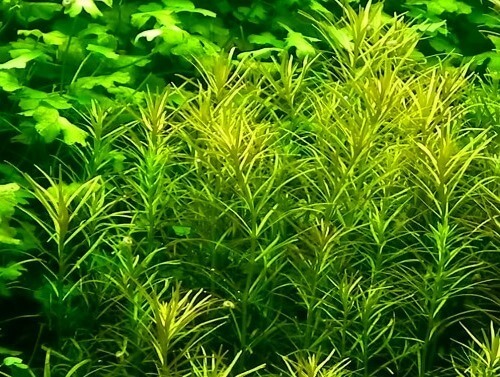
- Scientific name: Rotala sp. ‘Nanjenshan’
- Position: Midground
- Care level: Easy
- Growth rate: Fast
- Height: 4 – 12 inches (10 – 30 cm)
- Lighting: Low to medium
- CO2: Optional
Rotala sp. ‘Nanjenshan’ is distinguished by its thin, needle-like leaves and bushy, arching stems that form compact, rounded clumps. Its fresh green coloration and gentle, flowing growth bring natural dynamism to aquascapes, making it an excellent midground or background choice for layouts seeking texture without excessive height. This plant adds a soft, organic feel to any tank.
In aquariums, Rotala sp. ‘Nanjenshan’ enhances visual depth when paired with bold or darker plants, such as Ludwigia or Staurogyne. Its dense, graceful clumps are safe for peaceful tank mates like shrimp and tetras, integrating seamlessly into community setups. The plant’s ability to create a lush, textured appearance makes it a popular choice for aquarists aiming for a natural, harmonious aquascape.
Rotala indica
- Scientific name: Rotala indica
- Position: Midground to background
- Care level: Easy
- Growth rate: Fast
- Height: 8 – 16 inches (20 – 40 cm)
- Lighting: Low to high
- CO2: Optional
Rotala indica is a compact, upright species with light green to pale orange leaves, offering subtle color and a tidy appearance that distinguishes it from its often-confused cousin, Rotala rotundifolia. Its slower growth and manageable size make it ideal for small tanks or as a spacing element between more aggressive stem plants, adding clarity and balance to aquascapes.
In planted tanks, Rotala indica serves as a versatile midground or background plant, creating a neat, structured look without overpowering other species. Its compatibility with peaceful fish and shrimp, such as platies or Neocaridina, ensures it fits well in community aquariums. The plant’s understated beauty makes it a great choice for aquarists seeking a low-maintenance, harmonious addition to their layouts.
Rotala ramosior
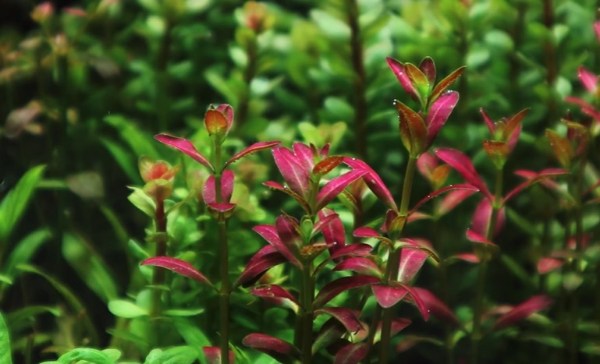
- Scientific name: Rotala ramosior
- Position: Midground to background
- Care level: Easy
- Growth rate: Moderate
- Height: 6 – 16 inches (15 – 40 cm)
- Lighting: Low to medium
- CO2: Optional
Rotala ramosior, a lesser-known North American native, features small, rounded leaves that can develop bluish to pinkish tones under optimal conditions. Its refined, understated beauty and moderate growth rate make it a unique addition to structured aquascapes, offering subtle color and texture that complements more vibrant or larger plants.
In aquariums, Rotala ramosior shines as a midground or background plant, adding a delicate, uncommon aesthetic to layouts. Safe for peaceful tank mates like rasboras and shrimp, it integrates well into community tanks. Its distinctive coloration and manageable growth make it an appealing choice for aquarists looking to incorporate a rare, elegant species into their designs.
Rotala sp. ‘H’ra’
- Scientific name: Rotala sp. ‘H’ra’
- Position: Midground
- Care level: Easy
- Growth rate: Fast
- Height: 6 – 12 inches (15 – 30 cm)
- Lighting: Medium to high
- CO2: Recommended
Rotala sp. ‘H’ra’, likely a variant of Rotala rotundifolia, is a striking plant with slender leaves displaying warm copper-orange to reddish tones. Its gracefully arching stems create a flowing, river-like motion when planted in groups, adding an ethereal quality to nature-style aquascapes. This plant’s warm hues make it a captivating focal point.
In planted tanks, Rotala sp. ‘H’ra’ enhances the midground or background with its vibrant color and soft, dynamic growth, contrasting beautifully with green plants like Anubias or mosses. It is compatible with peaceful fish and shrimp, fitting seamlessly into community setups. Its ability to blend warmth and elegance makes it a favorite for aquarists seeking a unique, visually striking addition.

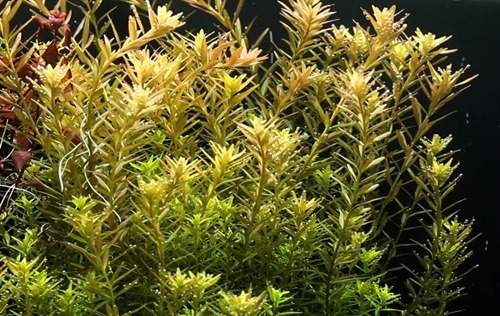 Rotala rotundifolia #ad
Rotala rotundifolia #ad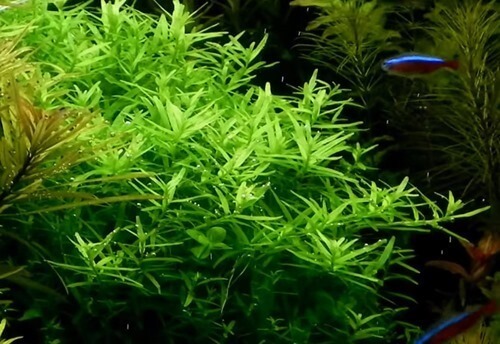 rotala-rotundifolia-green #ad
rotala-rotundifolia-green #ad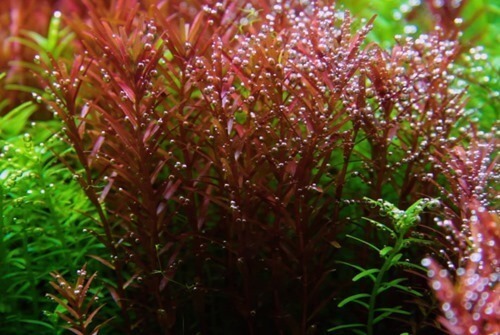 rotala-rotundifolia-red #ad
rotala-rotundifolia-red #ad Rotala wallichii #ad
Rotala wallichii #ad Rotala indica #ad
Rotala indica #ad Rotala-sp.-Hra #ad
Rotala-sp.-Hra #ad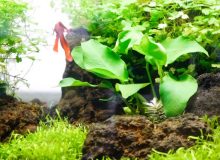
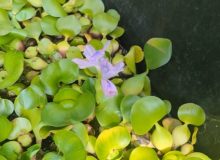

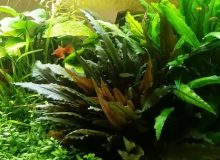
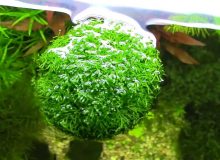
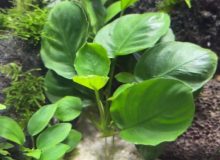
When I see pictures of rotala rotundifolia on the Internet, I always see photos like these. However, the ones I have are showing much more rounded leaves; do they need time to grow/mature?
Thanks,
Eric
Hi Eric,
R. rotundifolia is capable of producing different leaf shapes, sizes and colors depending on environmental factors such as light, nutrients, temperature etc. Round leaves means the plant has been grown emersed and you will see new narrow leaves soon after submersed.